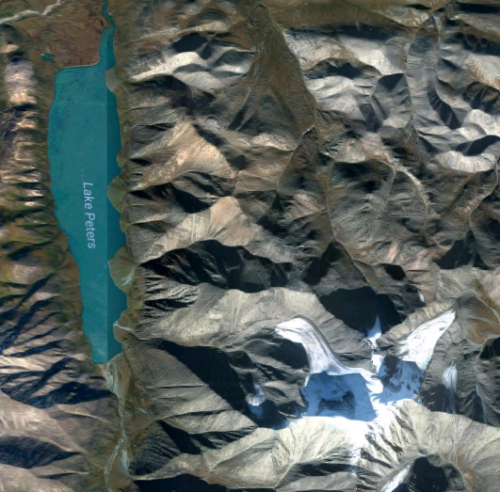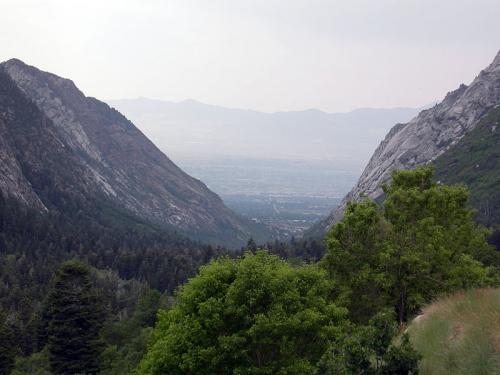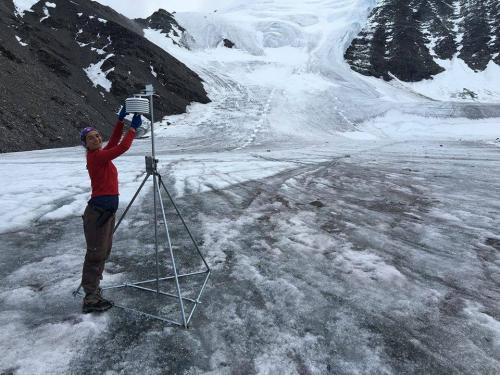This is the third journal in a series of posts explaining the science of our expedition.
One of our tasks in the field is monitoring Chamberlin glacier. Understanding how glaciers change over time and impact other systems (in our case, sedimentology and hydrology) is crucial for understanding Arctic systems. Glaciers form when snow accumulates in the same place year after year, so only occur at high elevations and the poles. Chamberlin glacier is a mountain glacier, as its snow accumulates high in the Brooks Range.
 Can you spot Chamberlin glacier (bottom right)? (Credit: Imagery 2017 DigitalGlobe,Landsat/Copernicus, Map data 2017 Google)
Can you spot Chamberlin glacier (bottom right)? (Credit: Imagery 2017 DigitalGlobe,Landsat/Copernicus, Map data 2017 Google)
The key to understanding glaciers is physics. Mass, or the amount of matter in an object, determines the force due to gravity. When snow first falls, it is fluffy. The snowflake's density is low due to its crystal structure. When more snow falls, the mass of the snow above creates downward pressure due to gravity, compacting the snow below and increasing its density. Over time, more and more snow accumulates, increasing the downward pressure. When the force is great enough, the ice begins to slowly flow downhill, even though the glacier may appear unchanging.
 As snowflakes are buried, the mass of the snow above applies pressure and compacts them into dense ice.
As snowflakes are buried, the mass of the snow above applies pressure and compacts them into dense ice.
The flowing glacier acts as a giant bulldozer, pushing everything in its path and grinding rock into fine sediments. When they melt, they leave behind signs of their movement. Piles of rocks, called moraines, show the glacier's terminus (end) and sides. And larger geographic features, like aretes, cirques, jagged peaks, and valleys show evidence of huge glaciers from long ago.
 Little Cottonwood, in the Wasatch Mountains of Utah, was carved by glaciers.
Little Cottonwood, in the Wasatch Mountains of Utah, was carved by glaciers.
Every glacier has an accumulation area, usually at the top of a mountain, where snow is accumulating, and an ablation area, at the bottom of the glacier, where ice is melting and evaporating. If more ice is ablating than accumulating, the glacier will retreat, or get smaller. If more ice is accumulating, the glacier will advance, or get longer. During the end of the Pleistocene, around 10000 years ago, when the Earth was experiencing an ice age, glaciers expanded to cover around a third of all land on the planet. In Utah, we see signs of extensive glaciers in the carved features of the Wasatch Mountains, even though only the tiny Timpanogos glacier remains. Since then, the planet has warmed and glaciers have reduced in size. In the last hundred year, glaciers have been shrinking at unprecedented rates, which have increased in the last decade. Scientists predict glaciers to all but disappear by the end of the century in areas known for glaciers, like the Alps, Himalayas, and Glacier National Park.
Disappearing glaciers can cause changes to glacier fed ecosystems, and are a concern for humans as well. Glacial ices stores about 2/3 of all of the freshwater on earth. Many human populations rely on the slow release of water from summer melt for drinking and agriculture. If glaciers disappear, those communities will no longer have access to a reliable source of fresh water.
Glaciers are also important for scientists, because they can tell us a lot about the history of the planet. Glacial extent, measured by locating old moraines, examining old records like photographs and paintings, or ablation stakes pounded into the ice give us clues about how the temperature of the planet has changed over time. Seasonal layers in the ice trap bubbles which can be analyzed to measure past atmospheric composition. And sediment from glaciers, as I'll explain in my next science post, can trap clues about the past as well.
 Ellie Broadman adjusts a weather station on Chamberlin glacier.
Ellie Broadman adjusts a weather station on Chamberlin glacier.

Add new comment